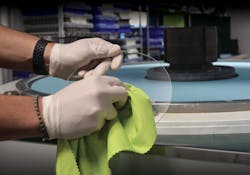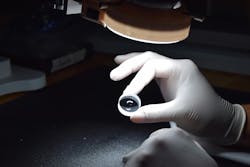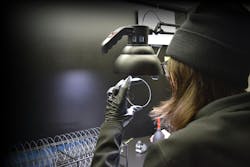Advancing optical manufacturing for future applications
Editor's note: Listen to our podcast interview with Lee Steneken below, which we released on November 11, 2025.
Technological advancements are a driving force behind the increased complexity of precision optics manufacturing. The demand for higher resolution, greater accuracy, and enhanced functionality has led to the incorporation of cutting-edge manufacturing machines and advanced metrology tools. A precision optical component made and measured 10 years ago may be completely obsolete with today’s manufacturing and inspection methods.
While consumer expectations and industry requirements are continuously evolving, manufacturers should have the awareness of progressing quality throughout production. For example, although Esco Optics has advanced inspection and metrology tools, there will always be new technologies emerging. From camera resolutions on interferometers to surface quality analysis profilometers, it is critical to deliver an optic that exceeds all measurable standards to customers, because they may be designing a system based on tomorrow’s technology.
While optical manufacturers keep up with metrology advancements, optical engineers push the limits of materials. High-index glasses, crystals, and even engineered polymers are now commonplace on production floors. These materials offer unique optical properties, but can be challenging to machine and polish. Manufacturers must find the perfect balance of consumables to accurately process emerging materials.
The days of barnsite and felt pads are behind us. Every glass with a new chemical composition needs to be mated with a reactive chemistry that allows polishing technicians to remove material and achieve exceptional quality. The simple selection of the proper polish and pad are paramount in today’s manufacturing world. Optics fabrication is a fluid puzzle of variables—understanding and controlling these variables is what gives us the opportunity to be better.
Along with technological and manufacturing advancements, the demand increases for skilled technicians, engineers, and designers with a deep understanding of optics and the manufacturing processes. The most common problem all U.S. optics manufacturers are facing is a workforce shortage. The industry is seeing skilled laborers retire, with little interest in manufacturing from individuals approaching employment age. We are seeing a void in the national workforce that must be addressed, because a shortage of qualified personnel can pose a significant challenge to the industry’s ability to meet rising demands.
Technologies, consumables, and workforce development
How the industry reacts to these ever-changing dynamics will define U.S. optics manufacturers’ resilience in the future. So, how do we as an industry react? The changes within this industry are constant. We must do everything we can to keep up, and it’s when we find ourselves unsure of our position that we have the opportunity for our greatest success.
Matching inspection methods is key to aligning companies’ expectations and performance. In instances where inspection methods do not align, third party confirmations are available throughout the industry. In many cases, a component can be measured by independent contractors or metrology tooling manufacturers. This option is less expensive for one-offs, but can become costly for long-running projects. Creating and maintaining collaborative relationships with many of the leading inspection companies in the industry is key. From laser damage threshold testing to infrared interferometry, there is always a way to confirm your specifications by simply making a phone call.
Manufacturing process and consumable selections can make or break an optic. Esco, for instance, has fine-tuned its fabrication by creating vertical integration from the blank processing to final polishing and thin film coating. To do this, the company purchases raw material direct from the glass manufacturers and cut blanks internally. Homogeneity is tested on transmission-sensitive projects to ensure optimum results. Taking quality-assurance measures at the beginning of the production cycle results in less product loss and manufacturing inefficiencies. Quality control is best practiced throughout all of production, not just when the project is finished.
As components make their way through the shop floor, they touch a variety of consumables. Understanding and controlling these consumables is vital for successful manufacturing. Cerium, zirconium, and even diamond slurries are constantly changing. Routine visitations and demonstrations from consumable manufacturers allow a better understanding of the use of materials in relation to the optics being fabricated. With a fleet of double-sided lapping and polishing machines, Esco can produce repeatable parts in high volume, while also perfecting production recipes on operation cells dedicated to production improvement.
Production methods are also advancing. Optical lens generators and polishers have come a long way. Operating multiple CNC machines, as Esco does, achieves exceptional accuracy. These machines perform in similar ways to conventional machinery, but at much more efficient rates while providing engineers the ability to confidently design a lens with aggressive departures and ultra-precision accuracies.
As the industry continues to move forward at a rapid pace, the development of the workforce is of utmost importance. Like other companies, Esco has spent time creating an in-house training platform to educate and guide technicians. As master opticians retire, we must record and pass down their years of knowledge to the technicians of tomorrow. But this is not enough—we need help.
Workforce development programs such as those offered by the American Precision Optics Manufacturing Association (APOMA) are becoming increasingly important. The Optics Manufacturing Technician Apprenticeship Program as well as community college-based optical systems technology programs across the country are wonderful programs that have been created to support workforce development in optics manufacturing. Industry awareness and educational opportunities are the keys to our opticians’ futures.
Esco has created relationships with local schools to inspire and enlighten students as they set their sights on the future. The engagement of these students and potential technicians is a focus for other optics manufacturers, as well, nationwide.
Precision optics manufacturing is undoubtedly becoming more challenging due to a confluence of factors: technological advancements, evolving customer demands, materials and consumables complexity, and the need for specialized expertise. Industry leaders must recognize these challenges and work collaboratively to develop innovative solutions that address the complexities while maintaining the high standards of precision and quality that define the field. By embracing these challenges as opportunities for growth and innovation, companies can continue to thrive in an ever-changing landscape.
About the Author
Lee Steneken
President & CEO, Esco Optics
Lee Steneken is president & CEO of Esco Optics (Oak Ridge, NJ), as well as president of the American Precision Optics Manufacturing Association (APOMA) board.



